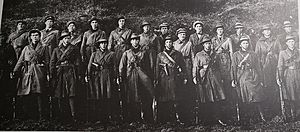Flying column facts for kids
A flying column is a small group of soldiers. They can move very quickly. These groups are often made up of different types of military units. They are usually put together for a special mission.
Flying columns are smaller than a full army brigade. Their main goal is to move fast. So, they carry only the most important equipment. In the past, they used horses to travel quickly. Today, they might use trucks or even helicopters.
Contents
History of Flying Columns
Ancient Tactics: Sun Tzu and Rome
The idea of flying columns is very old. A famous Chinese general named Sun Tzu wrote about them. He mentioned them in his book, Art of War. This book was written a long, long time ago, maybe around 600 BC. This shows that soldiers knew about fast-moving units even then.
The Roman army also used flying columns well. A Roman leader named Germanicus Caesar used them in battles. He fought against the Germanic tribes. These tribes had destroyed three Roman legions before. Germanicus used fast-moving scouts and raiders. They helped him fight against these enemies.
Boer Fighters and British Forces
In South Africa, groups called Boer kommandos were like flying columns. This was between the 1600s and early 1900s. They were very good at moving quickly.
During the Second Boer War (1899–1902), the British Army also used mobile columns. These groups were usually made of two infantry battalions. They also had artillery and cavalry. This was about half the size of a full brigade.
Guerrilla Warfare and Irish Independence
Flying columns have been very useful in guerrilla warfare. This is a type of fighting where small groups use surprise attacks. A famous example is the Irish Republican Army (IRA). They used mobile armed units during the Irish War of Independence (1919–1921).
These Irish flying columns were very effective. Some of the most successful were in west Connemara and south Mayo. The west Mayo column was led by Michael Kilroy.
Modern Examples of Flying Columns
In 1919, a Polish officer named Stanisław Maczek created a "flying company." This group had tough infantry soldiers. They used horses to move fast. They also had many machine guns for strong firepower.
In the 1920s, Canada had a plan called "Defence Scheme No. 1." It was about how to respond if the United States invaded. A leader named Lt. Col. James "Buster" Brown suggested sending out flying columns right away. These columns would cross the border. They would use a "scorched earth policy." This means destroying things like crops and supplies. This would force the US to use soldiers to defend its own cities.
During and after the Anglo-Iraqi War in 1941, British forces used flying columns. They had special code names like Kingcol, Mercol, and Gocol. Kingcol moved into Iraq from Jordan and Palestine.
See also
- Jock column
- Combe Force
- Durruti Column
- Long Range Desert Group
- Kampfgruppe



